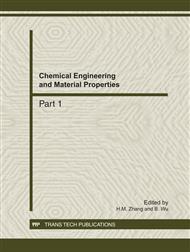p.1239
p.1244
p.1248
p.1253
p.1259
p.1263
p.1268
p.1273
p.1278
Effect of the Surface Morphology of Calcium Carbonate on the Impact Toughness of Polyamide 6/EPDM-M/CaCO3 Ternary Composites
Abstract:
Ternary composites of polyamide 6 (PA6), mixed with unmaleated ethylene propylene diene terpolymer rubber (named as EPDM-M) and calcium carbonate (CaCO3, with three different kinds of surface morphology) were prepared via two-step melt blending process. The influence of surface morphology of CaCO3 on the impact toughness of PA6/EPDM-M/CaCO3 was investigated. It was found that the Izod impact strength of the composites improved with increasing of the surface area of CaCO3. The characterization of CaCO3 by BET tester and scanning electron microscope (SEM) obviously showed that both needle-shaped CaCO3 and spherical CaCO3 were have a bigger specific surface area and rougher morphology than ground CaCO3. So they have a better toughen effect, which was well explained the results of impact test. Morphology observed on the impact fracture revealed that the formation of voids by the debonding of CaCO3, which could trigger the matrix emerged obvious plastic deformation in the composites that included needle-shaped CaCO3 or spherical CaCO3. This phenomenon also can be demonstrated that needle-shaped CaCO3 and spherical CaCO3 had superior toughen effective. Consequently, the surface morphology of CaCO3 had a distinctive effect on the toughness of PA6/EPDM-M/CaCO3 Composites.
Info:
Periodical:
Pages:
1259-1262
Citation:
Online since:
December 2011
Authors:
Keywords:
Price:
Сopyright:
© 2012 Trans Tech Publications Ltd. All Rights Reserved
Share:
Citation:


